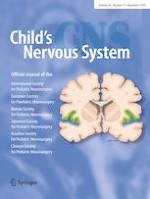Erschienen in:

28.05.2020 | Original Article
Keystone flap: a safe coverage option in the handling of salvage for myelomeningocele
verfasst von:
Oswaldo Gómez, Carlos Barrera
Erschienen in:
Child's Nervous System
|
Ausgabe 11/2020
Einloggen, um Zugang zu erhalten
Abstract
Background
Myelomeningocele (MMC) is the most common and severe pathology of open spina bifida compatible with life. Its early closure is an urgent therapeutic objective to reduce the morbidity and mortality of neonates, being a surgical challenge with two major objectives: (1) achieve closure of the dural cerebrum-spinal fluid fistula and (2) ensure a stable and durable soft tissue coverage. The use of fasciocutaneous flaps in keystone design is shown as a safe and stable surgical option with excellent aesthetic results in patients with MMC and who presented failed primary closures.
Methods
Two clinical cases of fasciocutaneous flaps in keystone design were described as a coverage option in patients with lumbosacral MMC, in whom the primary closure was unsuccessful and required a safe coverage as a priority.
Results
Successful coverage of the lumbosacral defect was performed using keystone flaps in neonatal patients with MMC and previous manipulation of the soft tissues when attempting primary closure, but they have had dehiscence of the wound, with a large area of lumbosacral defect and sizeable defect/back ratio.
Conclusions
The use of keystone flaps is a useful, accessible, and versatile technique as a management option for lumbosacral coverage defects in MMC, achieving a stable and safe covering of the meninges, without cerebrum-spinal fluid fistulas, which also allows the primary closure of the soft tissues in the donor area. The safety of this type of flap when used as salvage in lumbosacral defects with previously handled and raised tissues could infer that it is reliable enough to be considered as a first surgical option in the initial management of MMC.